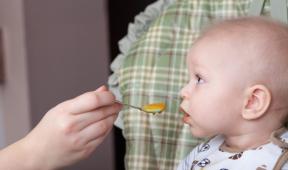Complementary feeding and CMPA in babies
Overview
What’s the best way to manage complementary feeding for a baby with CMPA?
It’s easier for parents to manage complementary feeding if they are supported by an allergy specialist or dietician who can help them get into good habits and teach them how to properly decipher labels and information likely to indicate an allergenic product.
Parents should therefore get into the habit of always checking the list of ingredients: milk is a major allergen which must be indicated in bold on the product packaging, as must all allergenic ingredients (nuts, fish, soya, etc.).
It’s important to guide families because even if some ingredients are clearly identifiable as containing milk (milk, butter, cream), the composition of other products may be less obvious (biscuits, rusks, mayonnaise).
Complementary feeding stages in the event of allergy
The fact that a baby is allergic to cow’s milk protein does not alter the way foods other than milk should be introduced. Complementary feeding should be introduced gradually, taking the necessary precautions in the event of known CMPA. The main stages to introduce new foods to baby’s diet are indicated below:

Depending on the digestive development of babies with CMPA, it is recommended to favour certain food groups. Below is an example of a diet for a baby aged between 4 and 7 months:

At between 7 and 15 months of age, a baby with CMPA begins gradually expanding his diet. The summary table below indicates the different recommended intakes at this age:

Legally-required information: Clarifications about the indication: “may contain traces of milk”
Manufacturers are in the habit of indicating this statement when there may be traces of milk in a product. This can happen when products containing milk are made in the same factory, with the same equipment. This very cautious labelling practice is useful for people with very severe allergies that can trigger very serious clinical signs if even the tiniest amount of the allergen is ingested.
If the baby has not had any very serious manifestations of his milk allergy and following the medical advice of a health professional, it is possible to give him cereals in which it is indicated "possible presence of milk". It will simply be necessary to start with very small quantities and to gradually increase them while watching for possible reactions from baby.



